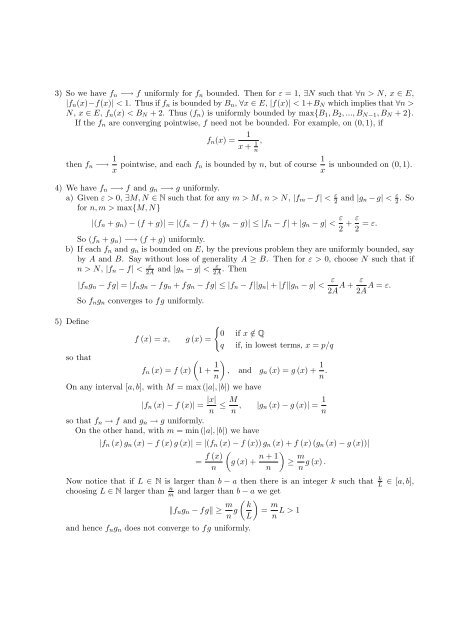18.100B Problem Set 9 Solutions - DSpace@MIT
18.100B Problem Set 9 Solutions - DSpace@MIT
18.100B Problem Set 9 Solutions - DSpace@MIT
You also want an ePaper? Increase the reach of your titles
YUMPU automatically turns print PDFs into web optimized ePapers that Google loves.
3) So we have f n −→ f uniformly for f n bounded. Then for ε = 1, ∃N such that ∀n > N, x ∈ E,<br />
|f n (x)−f(x)| < 1. Thus if f n is bounded by B n , ∀x ∈ E, |f(x)| < 1+B N which implies that ∀n ><br />
N, x ∈ E, f n (x) < B N + 2. Thus (f n ) is uniformly bounded by max{B 1 , B 2 , ..., B N−1 , B N + 2}.<br />
If the f n are converging pointwise, f need not be bounded. For example, on (0, 1), if<br />
1<br />
f n (x) = ,<br />
x + 1<br />
n<br />
1 1<br />
then f n −→ pointwise, and each f n is bounded by n, but of course is unbounded on (0, 1).<br />
x<br />
x<br />
4) We have f n −→ f and g n −→ g uniformly.<br />
ε<br />
a) Given ε > 0, ∃M, N ∈ N such that for any m > M, n > N, |f m − f| < 2<br />
and |g n − g| < ε 2<br />
. So<br />
for n, m > max{M, N}<br />
ε ε<br />
|(f n + g n ) − (f + g)| = |(f n − f) + (g n − g)| ≤ |f n − f| + |g n − g| < + = ε. 2 2<br />
So (f n + g n ) −→ (f + g) uniformly.<br />
b) If each f n and g n is bounded on E, by the previous problem they are uniformly bounded, say<br />
by A and B. Say without loss of generality A ≥ B. Then for ε > 0, choose N such that if<br />
ε<br />
n > N, |f n − f| < 2 A and |g ε<br />
n − g| < 2 A . Then ε ε<br />
|f n g n − fg| = |f n g n − fg n + fg n − fg| ≤ |f n − f||g n | + |f||g n − g| < A + A = ε.<br />
2A 2A<br />
So f n g n converges to fg uniformly.<br />
5) Define <br />
0 if x /∈ Q<br />
f (x) = x, g (x) =<br />
q if, in lowest terms, x = p/q<br />
so that <br />
1 1<br />
f n (x) = f (x) 1 + , and g n (x) = g (x) + .<br />
n<br />
n<br />
On any interval [a, b], with M = max (|a|, |b|) we have<br />
|f n (x) − f (x)| = |x| M , = 1<br />
n ≤ |g n (x) − g (x)|<br />
n<br />
n<br />
so that f n → f and g n → g uniformly.<br />
On the other hand, with m = min (|a|, |b|) we have<br />
|f n (x) g n (x) − f (x) g (x)| = |(f n (x) − f (x)) g n (x) + f (x) (g n (x) − g (x))|<br />
<br />
<br />
f (x) n + 1 m<br />
= g (x) + ≥ g (x) .<br />
n<br />
n n<br />
Now notice that if L ∈ N is larger than b − a then there is an integer k such that k L<br />
∈ [a, b],<br />
n<br />
choosing L ∈ N larger than<br />
m<br />
and larger than b − a we get<br />
<br />
m k m<br />
f n g n − fg ≥ g = L > 1<br />
n L n<br />
and hence f n g n does not converge to fg uniformly.

















